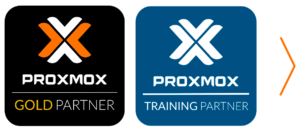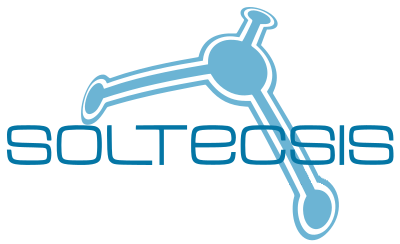Proxmox VE
Proxmox Virtual Environment (Proxmox VE) is a hyperconverged, open source virtualization business solution that integrates virtualization through KVM/QEMU, LXC containers and Ceph storage on the same platform, which has a low cost of ownership, professional support and the possibility to get official training.

Soltecsis, GOLD PARTNER of Proxmox and the first officially approved TRAINING PARTNER to give official Proxmox VE training in Spanish.
Why use Proxmox VE?
By means of the virtualization of Operating Systems, Apps and workloads your Data Centre can be adapted efficiently to your business requirements as they evolve, simply scaling resources both related to computing and storage, in order to effectively make the very most of your investment in hardware. Furthermore, it helps you manage the life cycle of your services and data by using backups, snapshots, clones and replications.
Software-defined architecture
Proxmox VE supports software-defined networking (SDN) and software defined storage (Ceph), which allows for great versatility to adapt to the hardware available and to the connectivity requirements needed:
- Scale and segment your networks to increase security, either by using the integrated firewall or another dedicated administrator connection by means of FWCloud.
- It implements Ceph to have redundant, scalable and self-managed storage using the same cluster nodes.
High availability
Proxmox VE includes High Availability options by creating multimaster clusters and its HA Manager service. The integrated data replication tools enable you to define a disaster recovery plan and protect your data and your services from any possible hardware or software failures, as well as from security-related incidents. Of course, it includes backup solutions to have backup copies of your data and services, and it also has a Proxmox Backup Server, which is a separate tool that enables you to have deduplicated and compressed backups of all your platforms.
Compatibility and scalability
Thanks to it being highly compatible with a wide range of Proxmox VE hardware you won’t have to confine yourself to the solutions of just one manufacturer, instead you will be able to choose the most appropriate hardware at all times, and use clusters with heterogeneous hardware of a large number of nodes.
Detailed features
Licensing
All the features are included under the GNU Affero General Public License, v3 (GNU AGPL, v3). Proxmox VE is based on Debian GNU/Linux.
Virtual machines
Virtual machines are supported by means of KVM/QEMU, the technological leader in Linux to execute virtual workloads with the minimum loss of performance with regard to the use of dedicated hardware. Both Windows and Linux are completely supported, and there is partial support for other operating systems such as FreeBSD or macOS.
LXC containers
By using the host kernel the Linux lightweight virtualization workloads can be used, at the same time as they are run in a work space that is totally separate from this and between these.
Cluster
Clusters with a minimum of 2 nodes can be configured (3 if Ceph is implemented) up to about 40 nodes. There is no predefined maximum, but it will depend on the network and hardware latency.
High availability
The Proxmox VE HA Manager service is in charge of supervising how the cluster, virtual machine and container nodes work, action is taken if one of these goes down or there is an incident with a node. There is a simulator that can be used to test its HA configuration before implementing it to make sure it meets the corresponding requirements.
Administration
Proxmox VE can be administered through the Web interface, command line and API REST that allows you to integrate Proxmox VE with other existing tools. Furthermore, operations can be carried out in the whole cluster from any of the nodes thanks to the exclusive multimaster architecture implemented by means of the Proxmox Cluster File System (pmxcfs).
Data storage
· Local disk drives such as SATA, SAS or NVMe, using LVM, LVM-thin, ext4, xfs or ZFS (among others). · SAN storage accessed through iSCSI (iSCSI/kernel, iSCSI/libiscsi, ZFS on iSCSI), Fiberchannel, NFS or CIFS. · SDS hyperconverged storage on the actual nodes of the cluster using Ceph/RBD or CephFS.
Networking
It supports the use of bridges, link aggregation (bonding/LAG) and VLAN IEEE 802.1q. Through Open vSwitch (OVS), advanced SDN features such as RSTP, VXLANs and OpenFlow can be implemented.
Migration
It includes live KVM virtual machine migration support without losing the service, even if local storage is used. The operation can be carried out with or without a dedicated network and the bandwidth used in the operation can be limited. Of course, a virtual machine or container can also be migrated if this is idle.
Asynchronous replication
It supports virtual machine and container replication, regularly copying data from a node of a Proxmox VE cluster to another node of the same cluster, to therefore have a recent copy in another node.
Backups
Backups on Proxmox Backup Server (PBS) can be made, which compress and deduplicate the data of each backup. Complete compressed database dumps are also possible through vzdump.
Integrated firewall
It protects the network traffic of virtual machines, containers and the actual cluster nodes through the integrated firewall.
Contact
You can get in touch with us by phoning us, sending us an email or by filling in the following form:
Telephone number
Commercial Department: comercial@soltecsis.com Technical Department: soporte@soltecsis.com
Address
SOLTECSIS SOLUCIONES TECNOLÓGICAS, S.L. B54368451 C/Carrasca, 7 local 3 03590 Altea (Alicante) - España (+34) 966 446 046 / 966 919 929 info@soltecsis.com
"*" indicates required fields
